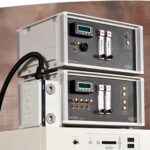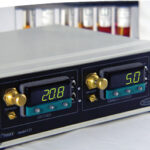 Cytocentric Visionaries: Jan Jensen, Trailhead BioSystems
Cytocentric Visionaries: Jan Jensen, Trailhead BioSystems
Part One: Unbiased Cell Science: Don’t Try to Out-Think Nature
Dr. Jan Jensen is the E. J. Brandon Endowed Professor in Diabetes Research at the Cleveland Clinic and also CSO of Trailhead BioSystems. Trailhead uses a unique combination of advanced technologies to define optimized combinations of growth factors that will efficiently guide cell differentiation from the embryonic state through specific cell lineage pathways.
Combining a Design of Experiments approach with robotics, mathematical modeling, high throughput gene analysis, and Cytocentric Isolators, Trailhead optimizes cell media 12 factors at a time to achieve step-by-step cell type conversion rates of well over 90%.
Here, Alicia talks with Dr. Jensen about how they had to let go of the past to progress. The part one interview below explores finding different signaling molecules with large scale computing and how it benefits scientific research.
Alicia Henn: We see you as a Cytocentric Visionary because you are not only using physiologically relevant oxygen levels, but you are also putting the cells first and letting them guide you to the right combination of differentiation signaling molecules in an unbiased way.
Jan Jensen: Yes, cytocentric is perhaps a good word. The closer we can get to the environment that the cells are in, the better data we’re going to get, and the more they’re going to give us the right answers.
AH: You and your team have seen quick success in finding the right combinations of medium additives to convert cells from one cell type to the next down different lineage pathways. What makes your approach so efficient?
JJ: We first asked, “how can one build a system that’s able to penetrate the information space that nature uses when it builds organisms?” Then we began the system design. The problem we faced is similar to other big data to knowledge problematics.
Whether it’s a weather system that develops or it’s a manufacturing company that needs to make tons of paper, it’s a computational problem that essentially can only be attacked by large scale computing efforts. This is essentially just the same approach.
It doesn’t matter what cell you look at, cells rely on multiple pathways for control of their differentiation state. The type of approach that we’re using with Design of Experiment Theory coupled with Multivariate Data Analysis has been used before to define optimal nutrition compositions for cell growth in larger culture vessels. Where we’re adding our technology is to truly address the signaling input space that the cells need for the differentiation state. It is Systems Developmental Biology.
While fundamental within basic science, it is critically important for clinical applications in regenerative medicine! Very little attention has been given by companies seeking to scale up cells for biologic production towards the actual differentiation state. We are working with cells that have a certain amount of differentiation wobble.
When nature is built on such an involved combination of signaling pathways and complexities, we can’t grasp it using individual experiments. For the sheer scale of our experimentation, the human mind must yield to technologies, computers and software.
When we do that, nature can tell us how it’s built rather than us trying to outthink it.
AH: So you try a lot of different signaling molecules on the cells in one big combinatorial matrix and then the readout is a large number of genes for each sample. Isn’t that a lot of data to parse?
JJ: This is essentially the reason that our multi-dimensional modeling works as well as it does because we do test a very large number of signaling inputs at the same time. We do it in a nonbiased way and get the cellular system to inform us about conditions that are particularly amenable to go into specific states.
Compared with traditional medium optimization, it’s a scale difference. You have to really do it large before it works. Unless you look at many genes, and perturb the systems in many dimensions, you are never able to extract enough information to piece together what is going on.
Also, it’s more important to measure what you don’t want to see, than to measure what you do want to see. That is contrary to how the mind works. We always measure what we think we want to see and we don’t measure things that we don’t want to see.
But, there is more than one signaling pathway in play at any given time point and because of that, these pathways highly interact with each other. These interactions are stabilized over millions of years of evolution, and we are now finally able to identify them statistically. That is why it’s so difficult if we just test one pathway at a time to figure out how the system is actually built. The system complexity will not budge against such a simple question. So why do it?
AH: So it is unbiased because it is the computer models alone that take all the gene expression data and then solve for the best combination of signaling molecules to get the gene expression levels desired from the cells?
JJ: Not only do we identify robust recipes, but we also identify the relative contribution of critical components. Therefore we can bring that to a process engineer, tell him we need this and that and that and that, with this relative need in your scale of effort. So that should capture the space in between basic science vs. industrial approach.
We built this system with the hope and the intent that it would be useful in identifying industrial grade process critical parameters. Not those that impact production of cars and bicycles, but are critical during production of actual living materials.
AH: Would you say that being able to assess the effects of so many different factors all at the same time is like having a whole keyboard to play instead of just one key at a time?
JJ: You can say that. While we are still learning where this technology can take us, we’re becoming more able to play the tune using the full set of keys. Just one at a time would make for a pretty boring song.
In Part Two, we continue our discussion with Dr. Jensen, talking about cell fate wobble and how cell reprogramming is “cheating.”
If you would like to be featured in our Cytocentric Visionary Series, contact us. We would love to hear about your work.
Recent Articles

Cytocentric Visionaries Hal Broxmeyer
Cytocentric Visionaries: Hal Broxmeyer November 27, 1944 ~ December 8, 2021 Hal Broxmeyer telling Randy Yerden about his latest findings in June 2016. The average height of the Cytocentric researcher has been reduced, now that we have lost a giant. Hal Broxmeyer died...

Cytocentric Visionaries: Dr. David Gozal, MD – Part Two
Cytocentric Visionaries: Dr. David Gozal, MD Part 2: COVID-19 Research, Prone Positioning, and Chronoadequacy Alicia Henn, PhD MBA, Chief Scientific Officer, BioSpherix David Gozal, MD, MBA, PhD (Hon) is the Marie M. and Harry L. Smith Endowed Chair and Chairperson of...

Cytocentric Visionaries: Dr. David Gozal, MD – Part One
Cytocentric Visionaries: Dr. David Gozal, MD Part 1: COVID-19, ACE2, and the Circadian Clock Alicia Henn, PhD MBA, Chief Scientific Officer, BioSpherix David Gozal, MD, MBA, PhD (Hon) is the Marie M. and Harry L. Smith Endowed Chair and Chairperson of the Department...
About The Author
Alicia D Henn, PhD, MBA
Chief Scientific Officer of BioSpherix, Ltd
Alicia Henn has been the Chief Scientific Officer of BioSpherix, Ltd since 2013. Previously, she was a researcher at the Center for Biodefense Immune Modeling in Rochester, NY. Alicia obtained her PhD in molecular pharmacology and cancer therapeutics from Roswell Park Cancer Institute in Buffalo, NY and her MBA from the Simon School at University of Rochester in Rochester, NY.
If you would like to be featured in our Cytocentric Visionary Series, contact us. We would love to hear about your work.





































